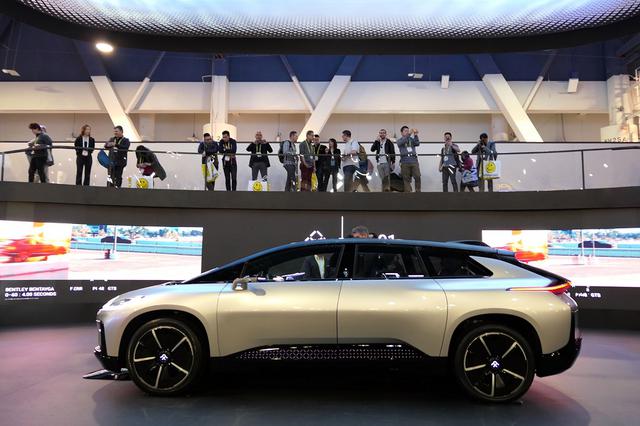Electric-vehicle companies, often raising capital through dubious mergers, have a problem with the truth, and it’s a problem for all of us on this planet.
BY DAVID DAYEN
DECEMBER 22, 2021

SINGAPORE PRESS VIA AP IMAGES
Faraday Future displayed their FF91 EV at the 2017 Consumer Electronics Show in Las Vegas.
Upon the news of the Build Back Better Act’s untimely death (well, it’s mostly dead), electric-vehicle stocks tanked. The bill had incentive payments of up to $12,500 for consumers purchasing an EV, and their loss could crush demand, especially for young companies banking on a robust market.
But the Biden administration’s revised fuel efficiency standard, setting a benchmark of 55 miles per gallon by the 2026 model year, does boost EV fortunes. The only way to get a fleet that green is to expand electrification, and that rising tide should give every company in the space new opportunities. Nationwide charging infrastructure, which was part of the bipartisan infrastructure law, also creates favorable conditions for EVs.
The green vehicle transition, in other words, is under way and inevitable, and large automakers are adapting to this reality. Planned fleets from Ford and Toyota include significant plug-in models. But electric cars will only become widely adopted when they get cheaper. With battery costs rising amid resource wars for the precious materials needed to produce them, that’s not likely to happen immediately. The best way to make EVs affordable over time is with more companies doing research and development, and the subsequent innovation and competition driving down prices.
That makes the crop of EV car and battery companies that have arrived on the scene really important. We know that electrification is the primary solution to mitigating the climate crisis. We are relying on this collection of entrepreneurs to lead the battle against greenhouse gas emissions.
That makes the fact that it’s hard to believe a word most of them say a real stumbling block.
We know that electrification is the primary solution to mitigating the climate crisis.
Nikola was briefly valued higher than Ford before the company was investigated over a host of false claims, including the allegation that its model car was pushed down a hill to make it look like it was steaming along an open road. The founder was later indicted, and Nikola paid $125 million to settle the probe. Lordstown Motors amended its annual report in June to state that it lacks the funds to start commercial production and may not survive the year. Selling its plant to Foxconn in November triggered a rally, but production has been pushed out another year, and it is also under federal investigation. Lucid stock tanked two weeks ago after the company admitted it had received a subpoena from the Securities and Exchange Commission about a recent merger.
It’s gotten so bad that Fisker, another EV startup, had to publicly announce that it was not under investigation to satisfy markets.
The common thread with these and many other EV companies is that they went public through a SPAC merger. SPACs, which stands for “special purpose acquisition companies,” are essentially vehicles to circumvent the more arduous process of an initial public offering. Instead, companies merge with the SPAC, which is just a shell company holding investor capital. That erases the paperwork and regulatory requirements necessary in an IPO, along with some legal exposure. One analyst puts the number of EV companies merging with SPACs at 22 since last April.
In theory, SPACs are a godsend for electric-vehicle companies with tremendous up-front funding needs, and no product to sell before realizing their vision. But in practice, EV SPACs have been an environment for any charlatan with a Brooks Brothers suit and an idea to part investors from their money with no hope of a return. And that’s a problem, given the centrality of electrification in a climate mitigation strategy.
The trajectory is by now familiar. The SPAC format allows EV founders to make outsized statements about their companies, including projections on revenue and profit. These projections end up being almost always wrong, typically by a wide margin. Canoo, XL Fleet, and battery maker Romeo Power have all curtailed their projections in recent months, in addition to the aforementioned companies under federal investigation.
SPAC sponsors and their target company enjoy a safe harbor from private litigation by investors, and can therefore fearlessly promote their merger. Sponsors can make out with a payday even if the company fails, creating even more incentive to overhype. “SPACs are havens for highly speculative pre-revenue businesses,” noted Andrew Park, senior policy analyst with Americans for Financial Reform. “You can make these ambitious forward-looking projections, but not be subject to the same liability as under an IPO. You’re monetizing hopes and dreams.”
Park has testified before Congress that nine EV SPACs had combined annual revenue in 2020 of $139 million, but they collectively projected revenues of $26 billion by 2024.
The SPAC format allows EV founders to make outsized statements about their companies, including projections on revenue and profit.
Far too many of the electric-vehicle companies that are going public through SPACs have no business being in the public markets. Take Faraday Future, one of many Chinese companies pushing into the EV space. (That includes, incredibly, Evergrande, the collapsing Chinese real estate firm, which is a large shareholder in Faraday in addition to having its own EV unit.)
J Capital Research, a short seller, released information in October showing that Faraday’s founder has a history of securities fraud and has been banned for life in China from interacting with public companies. Five promised factory locations were later abandoned, lawsuits from suppliers over unpaid bills are piling up, and the reservations for future vehicles are fake. (This was the problem with Lordstown Motors’ reservations as well; Faraday stopped talking about its reservations soon after that was discovered.) It’s unclear what the company has even been spending money on.
Interestingly, the one major EV company to avoid a SPAC is the truck maker Rivian, whose traditional IPO was wildly successful. Even there, however, the company had to cut its overstated production target last week while announcing it lost $1.2 billion in the last quarter, sending the stock to a new low.
In a way, the EV hype machine is just a reflection of its grand master, Elon Musk. Even today, after robust sales, Tesla’s stock price is a function of overheated options trading, and the company’s lies about its Autopilot system habitually face regulatory scrutiny. Meanwhile, overstated claims about production continue—in October, Tesla’s board chair promised 20 million sales annually by 2030, despite selling only half a million this year. Musk may be Person of the Year, but he’s not the best figure to emulate, especially in an industry as vital as EVs.
Unfortunately, outside of Tesla, which survived on public money and energy trading credits for years, the other investor capital in the industry is being showered on companies with little or no track record. This has created a lot of fevered speculation about which EV company will come out on top, which caters to retail investor speculation that is likely to end in a lot of tears.
“There needs to be a distinction between mindless speculation which will exist for the rest of human history, versus investments where people are being exploited, due to asymmetric information,” said Park.
Fortunately, the SEC has finally keyed in on the dangers of SPACs. Chair Gary Gensler gave a speech earlier this month where he said that “the investing public may not be getting like protections between traditional IPOs and SPACs,” and that he would seek proposals to improve investor protection through making better disclosures, barring dubious marketing practices without evidence to back them up, and requiring liability obligations.
That will certainly help to prevent fraud. But what does it do for this critical market? Lost in this hysteria is the fact that government investment kept Tesla alive in the 2010s. There are plenty of ways to direct up-front investment at companies in the public interest. Alternatively, you can do this through financial markets as well, as long as you’re not incentivizing fraud. Some will even fail, and that’s acceptable loss to get to the desired end point.
We need electric vehicles to succeed. They’re too important to put into the hands of professional liars.

DAVID DAYE is the Prospect’s executive editor. His work has appeared in The Intercept, The New Republic, HuffPost, The Washington Post, the Los Angeles Times, and more. His most recent book is ‘Monopolized: Life in the Age of Corporate Power.’
No comments:
Post a Comment